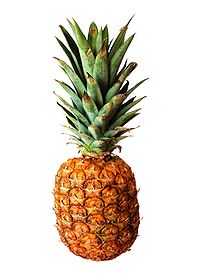Ananas
| Ananas | |
|---|---|
 | |
| Pineapple (Ananas comosus) | |
| Scientific classification | |
| Kingdom: | Plantae |
| (unranked): | Angiosperms |
| (unranked): | Monocots |
| (unranked): | Commelinids |
| Order: | Poales |
| Family: | Bromeliaceae |
| Subfamily: | Bromelioideae |
| Genus: | Ananas Mill. |
| Synonyms[1] | |
| |
Ananas is a plant genus of the Bromeliad family (Bromeliaceae), native to South America and Central America[1] which includes the species Ananas comosus, the pineapple.[1]
This genus originated in Mesoamerica and was brought to the Caribbean Islands by the Carib natives. The oldest register with the representation of the fruit seems to be included in the Cascajal Block, attributed to the Olmec civilization.[1]
In 1493, Christopher Columbus first saw plants of this genus in Guadeloupe. It was brought from Brazil to Europe by the Portuguese, and from there was distributed to the Pacific Islands by the Spanish and the English. Commercial pineapple plantations were established in Hawaii, the Philippines, Southeast Asia, Florida and Cuba. The pineapple has become one of the world's most popular fruits.[1]
The tough leaves grow in large rosettes, arising basally from a crown. These leaves are long and lanceolate with a serrate or thorny margin. The flowers, arising from the heart of the rosette, each have their own sepals. They grow into a compact head on a short, robust stalk. The sepals become fleshy and juicy and develop into the well-known complex form of the pseudocarp fruit, crowned by a rosette of leaves.[1]
Ananas species are used as food plants by the larvae of some Lepidoptera species including Batrachedra comosae, which feeds exclusively on A. comosus.
The word Ananas is derived from the Guarani name for the pineapple, via Portuguese. In most languages, pineapple is called "ananas".
Chemistry
Pineapples contain both bromelain and papain to which they owe their meat tenderizing properties.
Ethnobotanical uses
The fruit and roots are used by some peoples as anti-inflammatory, proteolytic agent, and a root decoction for diarrhea.
Production
The biggest producers in 2012 were the US (12.3%), Thailand (11.4%) and the Philippines (10.9%).
Species
- Ananas ananassoides (Baker) L.B. Smith - from Costa Rica to Paraguay
- Ananas bracteatus (Lindley) Schultes & Schultes f. - Brazil, Bolivia, Argentina, Paraguay, Ecuador
- Ananas comosus (Linnaeus) Merrill - Brazil and Paraguay; naturalized in parts of Asia, Africa, Australia, Mexico, Central America, the West Indies, northern South America, and various islands in the Pacific
- Ananas erectifolius L.B.Sm. - Peru, Ecuador, Colombia, Venezuela, northern Brazil, French Guiana
- Ananas lucidus (Aiton) Schult. & Schult.f - Peru, Ecuador, Colombia, Venezuela, northern Brazil, French Guiana
- Ananas macrodontes E.Morren - Brazil, Bolivia, Ecuador, Paraguay, northern Argentina
- Ananas parguazensis Camargo & L.B. Smith - Colombia, Venezuela, northern Brazil, Guyana, French Guiana
Gallery
-

Pineapple plantation
-

Ananas bracteatus var. striatus
-

Fruit of Ananas bracteatus var. tricolor
-

Ananas nanus, habitat, Suriname
-

A pineapple in a garden in Martinique (Caribbean Sea)
References
| |||||||||||||||||
